PIONEERING PILOTS OF SWEETWATER

A TEXAN’S HISTORIC PLAY AT THE MASTERS
THE MOST OVERLOOKED BIG BEND VISTA

PIONEERING PILOTS OF SWEETWATER

A TEXAN’S HISTORIC PLAY AT THE MASTERS
THE MOST OVERLOOKED BIG BEND VISTA
Dragonflies and damselflies rule Texas skies with deadly grace





With WaterFurnace, the average Texan pays $53/mo. to provide heating, cooling and hot water for their home.
WaterFurnace homeowners across the country are reaping the benefits of geothermal heat pumps by utilizing the unlimited reservoir of stored solar energy underground. A WaterFurnace geothermal system taps into this free and renewable resource to provide savings of up to 70% on heating, cooling, and hot water—with a comfort you have to experience to believe. Right now you can save thousands on installation thanks to a 30% federal tax credit2. Contact our WaterFurnace Concierges Team to learn more today!
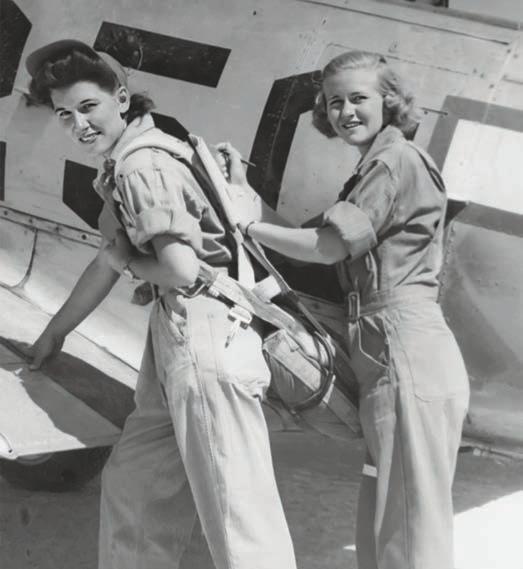
LeBlanc
By Sheryl Smith-Rodgers
Pam LeBlanc
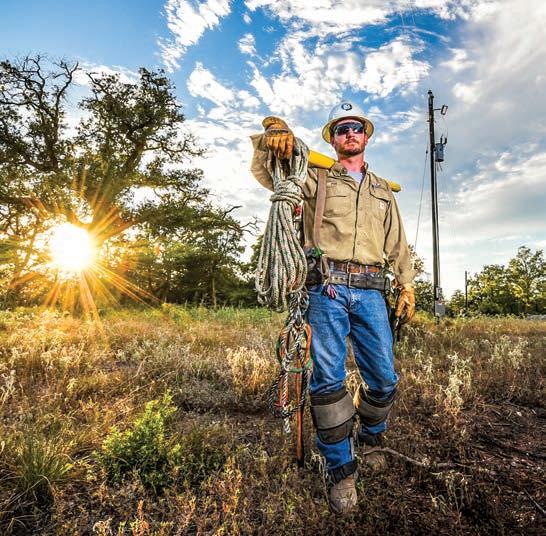
WILLIAM KAISER JOINS the rest of Co-op Country in saluting a special segment of the workforce April 14, National Lineworker Appreciation Day.
As a groundman in the late 1940s, Kaiser, 96, helped construct power lines in Central Texas for San Bernard Electric Cooperative.
He did so from the back of a Burma Jeep, unspooling line around Hallettsville, about halfway between San Antonio and Houston. Bringing electricity to rural Texas was backbreaking work in the years after co-ops got their start, and all these decades later, Kaiser is proud of his role.
“Somebody had to lay those lines out through the right-of-way so that they could hang the lines on the pole,” he says. “It takes a whole crew, many people, to get to where the lineman could do his job.”
A job, Kaiser notes, that wasn’t for him: “I’m not somebody who likes to get up in the air.”

A flower blossoms for its own joy.”
—OSCAR WILDE
best view in Texas is ...
Tell us how you would finish that sentence. Email your short responses to letters@TexasCoopPower.com or comment on our Facebook post. Include your co-op and town.
Here are some of the responses to our February prompt: My first car was ...
A 1953 Chevy with a nonworking reverse gear. Had to be creative in finding a place to park.
WANDA SIKES
TRINITY VALLEY EC TERRELL
Such a clunker that it was on my mechanic’s lift so much that it had more miles on it vertically than horizontally.
JOE POLINO TRI-COUNTY EC GRANBURY
A hearse! Specifically, a 1958 Cadillac coach by Miller-Meteor. My father wanted to make sure if I got in an accident, it would be the other guy who got hurt.
JAY WEBER
PEDERNALES EC ROUND ROCK
A used fluorescent yellow Ford Maverick. Living in a small town, my parents always knew where I was—no tracking/locator services needed!
PEGGY RUSTERHOLTZ
GRAYSON-COLLIN EC LUCAS
Visit our website to see more responses.

ENTER CONTESTS AT TEXASCOOPPOWER.COM
$500 RECIPE CONTEST
One-Skillet Dinners FOCUS ON TEXAS PHOTOS College Life RECOMMENDED READING
We sure love telling you about intriguing insects— as we did with The Bugs That Make You See Red in February 2019. Find it at TexasCoopPower.com.
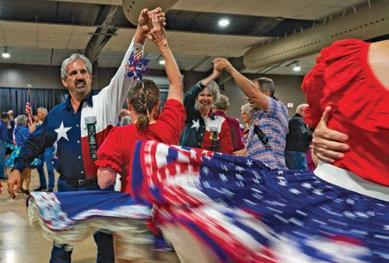
Fun For All
I plan to send It’s Hip To Be a Square [February 2025] to some folks who may be shy about trying square dancing or round dancing.
Cheryl Rush
Upshur Rural EC
Winnsboro
It brought back so many memories of when my hubby and I had a blast square dancing for so many years. It was very challenging, and the friendship was incredible.
Genny Pruitt Nueces EC Victoria
Not Light Reading
I enjoyed Field of Beams [December 2024] so much that I had a tear in my eye when I finished.
Roberta McLaughlin
Heart of Texas EC Lorena

FEBRUARY 2025 It’s Hip To Be a Square
“I square danced for 20 years. Nothing better for exercise, enjoyment, friendships.”
DONNA DEAN HUTCHERSON VIA FACEBOOK
Around age 10 my friend and I were walking on a trail that ended at a dirt road. We saw a large black bear less than a football field away [Our Nosy New Neighbors, January 2025]. We cried and ran.
Then, my friend stopped running and started laughing. I turned around and saw the bear running away from us. There were many black bears in Minnesota. None of our bear meetings turned out bad for anyone other than our garbage cans. But I still don’t think people will like having that many bears in Texas.
Tyler Carlson Pedernales EC San Marcos
Thank you for the informative articles in February [Currents and History to a Tea] about the achievements and contributions of Black Americans in the U.S. and world. It is much appreciated.
Gabrielle Gordon Tri-County EC Tarrant County
Editor, Texas Co-op Power 1122 Colorado St., 24th Floor Austin, TX 78701
Please include your electric co-op and town. Letters may be edited for clarity and length.
Texas Co-op Power
TEXAS ELECTRIC COOPERATIVES
BOARD OF DIRECTORS
Chair Avan Irani, Robstown
Vice Chair Bryan Wood, San Augustine
Secretary-Treasurer Cameron Smallwood, Burleson
Board Members Dale Ancell, Lubbock Matt Bentke, Bastrop • Kerry Kelton, Navasota • Mark McClain, Roby
PRESIDENT/CEO Mike Williams, Austin
COMMUNICATIONS & MEMBER
SERVICES COMMITTEE
Mike Ables, Bellville • Kathi Calvert, Crockett
Marty Haught, Burleson • Tachi Hinojosa, Fredericksburg • Gary Miller, Bryan Zac Perkins, Hooker, Oklahoma • Bryan Story, Blossom • Buff Whitten, Eldorado
MAGAZINE STAFF
Vice President, Communications & Member Services Martin Bevins
Editor Chris Burrows
Associate Editor Tom Widlowski
Production Manager Karen Nejtek
Creative Manager Andy Doughty
Advertising Manager Elaine Sproull
Communications Specialist Samantha Bryant
Digital Media Specialist Caytlyn Calhoun
Senior Designer Stacy Coale
Assistant Production Manager Alex Dal Santo
Print Production Specialist Grace Fultz
Food Editor Vianney Rodriguez
Communications Specialist Erin Sinclair
Communications Specialist Claire Stevens
Communications Specialist Kelly Tran
Proofreader Louie Bond
TEXAS CO-OP POWER Volume 81, Number 10 (USPS 540-560). Texas Co-op Power is published monthly by Texas Electric Cooperatives. Periodical postage paid at Austin, TX, and at additional offices. TEC is the statewide association representing 76 electric cooperatives. Texas Co-op Power’s website is TexasCoopPower.com. Call (512) 4540311 or email editor@TexasCoopPower.com.
SUBSCRIPTIONS Subscription price is $5.11 per year for individual members of subscribing cooperatives and is paid from equity accruing to the member. If you are not a member of a subscribing cooperative, you can purchase an annual subscription at the nonmember rate of $7.50. Co-op members: Please notify your co-op of address changes or other subscription requests.
POSTMASTER Send address changes to Texas Co-op Power (USPS 540-560), 1122 Colorado St., 24th Floor, Austin, TX 78701. Please enclose label from this copy of Texas Co-op Power showing old address and key numbers.
ADVERTISING Contact Elaine Sproull at (512) 486-6251 or esproull@texas-ec.org for information about purchasing display ad space in Texas Co-op Power and/or in our 26 sister publications in other states. Advertisements in Texas Co-op Power are paid solicitations. The publisher neither endorses nor guarantees in any manner any product or company included in this publication.
COPYRIGHT All content © 2025 Texas Electric Cooperatives Inc. All rights reserved. Reproduction of this issue or any portion of it is expressly prohibited without written permission. Willie Wiredhand © 2025 National Rural Electric Cooperative Association.


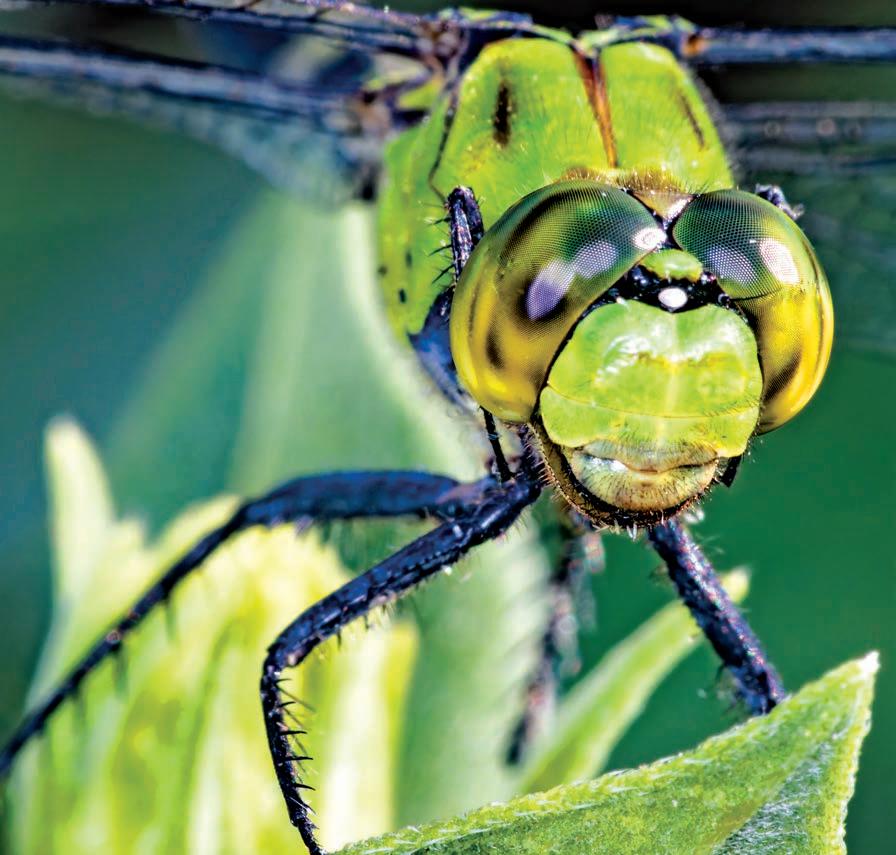


Texas’ diversity of colorful dragonflies and damselflies beguiles bird and butterfly watchers
BY SHERYL SMITH-RODGERS
n the grassy edge of a dry irrigation canal, an emerald green insect darted about in the air. Then it landed on the limb of a thorny mesquite.
Armed with a camera, amateur naturalist Tripp Davenport of Uvalde aimed his long lens at the dazzling dragonfly and quickly snapped photos before it flitted away.
That morning in July 2017, he had visited the National Butterfly Center in South Texas in hopes
CLOCKWISE FROM LEFT A female eastern pondhawk dragonfly; dragonflies and damselflies have compound eyes made up of thousands of tiny eyes called ommatidia. The eastern amberwing is one of the only dragonflies that mimics a wasp. The great spreadwing is one of the largest damselflies in North America, with a length up to 2.4 inches, a 3-inch wingspan and a notable yellow stripe. A male eastern pondhawk with its prey.
of spotting a red-mantled skimmer, a dragonfly from central Mexico that rarely ventures into Texas. Instead he found something even more special.
“When I looked at my images, I realized it was a dragonfly that I’d never seen before,” says Davenport, a high school teacher and Medina Electric Cooperative member. “And I’ve seen nearly all of them in Texas.”
Perplexed and excited, he called and texted pictures to some fellow naturalists. One beelined to Davenport’s location. Another researched records and nailed down the species. “It was a secretive darner that had only been photographed twice before, in central Mexico,” Davenport says. “My adrenaline was running!”
When you’re a dragonfly chaser, that’s what can happen. Like avid bird watchers, many chasers keep life lists of every species they’ve seen. Similarly, they may travel long distances in pursuit of dragonflies. Damselflies, too. The closely related insects, which have two pairs of long wings, elongated bodies and large compound eyes, are listed in the taxonomic group Odonata (derived from odont, a Greek root word for “tooth” that refers to their large chewing mandibles). Luckily for Texans, our state is home to hundreds of species.
Odonates (chasers call them “odes”) can typically be found near water but not exclusively. Their bodies come in a rainbow of hues—red, orange, yellow, green, blue and purple along with black and white. They can alternately beat and rotate their four membranous wings, enabling them to zip in all directions and even backward.
Using their aerial agility, odes hunt in the air and use their strong legs to snatch prey, such as butterflies, mosquitoes, bees and other insects, including other dragonflies. Odes have excellent vision, too. Not even the tiniest movement escapes their compound eyes made of thousands of tiny eyes called ommatidia.
Of the two groups, dragonflies can generally be identified by their thicker bodies and hindwings that are broader at their base than the forewings. They fly higher than damselflies and can reach speeds of up to 35 mph. At rest, dragonflies hold their wings open whereas damselflies fold their wings over their toothpick-thin bodies. Worldwide, odonate species total more than 6,430, a number that’s tracked virtually at Odonata Central. The website maintains an extensive database compiled from information submitted by users who report their dragonfly
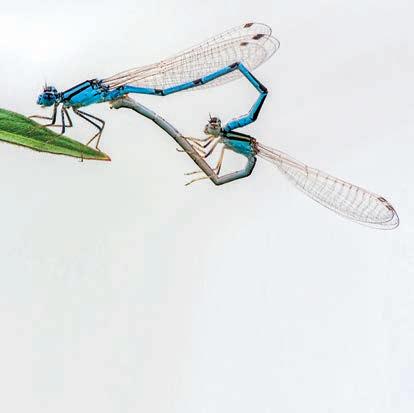
Butterflies and flies mate back-to-back. Not odonates. During mating, their slender bodies curl and join together (like these double-striped bluet damselflies) to form a heart-shaped “wheel” that’s unique among insects. They remain in this position for a few minutes or hours.
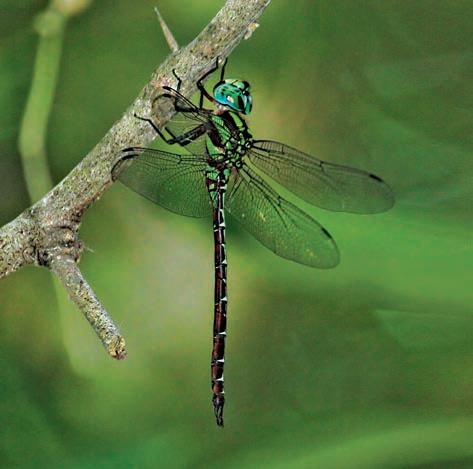
sightings and upload photos. According to the site, more than 490 odonate species occur in the U.S., and more than half (251 species) have been documented in Texas.
John Abbott, a Texas native who serves as the director of museum research and collections at the Alabama Museum of Natural History, has studied and written about dragonflies and damselflies since the early 1990s. Among his many publications, Abbott has authored Damselflies of Texas and Dragonflies of Texas, field guides published by the University of Texas Press.
In his opinion, there’s no better place than Texas to chase dragonflies.
“The state holds a unique geographic position where there’s mixing of eastern and western faunas and temperate and subtropical faunas,” Abbott explains. “This leads to the large number of odonate species that can be regularly observed in the state and tremendous opportunities for new species to be documented.”
He credits a growing number of natural history enthusiasts interested in odonates for making major contributions to what’s known about the species of Texas.
Among them are enthusiasts like Davenport and Martin Reid, a retired computer programmer from San Antonio who used to photograph mostly birds and butterflies.
“I got interested in dragonflies in 2001 when I saw a coollooking insect eating one of my butterflies,” Reid recalls. “I took a picture, and that was it. I was hooked on dragonflies.”
Since then, Reid has sought out odonates across the country as well as in Mexico, Peru, Panama, England and other distant places. But he prefers to focus on Texas species, of which he’s photographed 230.
“Whenever there’s been a new species found in the state, I dash out and try to catch up with it,” he says. “I get tips from Facebook or when someone texts me with a sighting.”
Life for dragonflies and damselflies begins in the water, where some species deposit eggs. Others insert eggs into
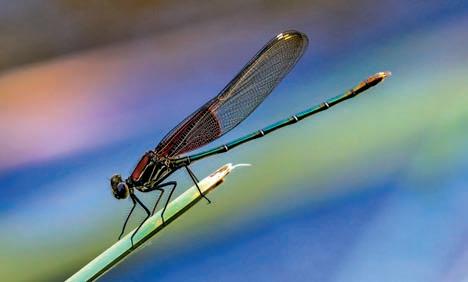

vegetation or rotting wood near water. From the eggs hatch aquatic larvae that look like big-eyed creepy crawlers. After shedding their hard skins in a series of molts, the nymphs emerge from the water and morph into winged adults.
All across Texas, adult odonates fly from spring through fall. Some occur year-round. Most adult damselflies live two to four weeks; dragonflies live four to six weeks. But some odonates survive several months.
They’re best found around freshwater, where they hunt and mate. Large open spaces, such as yards, fields and parking lots, may attract hungry odes in search of winged prey.
On their travels, Reid and Davenport have frequented the Christmas Mountains Oasis, 70 miles south of Alpine in far West Texas. Since 1996, owner Carolyn Ohl-Johnson, a member of Rio Grande Electric Cooperative, has worked to transform 5 acres of her scrubby ranchland into a lush hotspot for birds, butterflies, and, more recently, dragonflies and damselflies. So far, she has tallied 65 species.
“I remember when Tripp Davenport found a California spreadwing here,” she says. “Since then, I’ve had hundreds of them. People come here specifically to see them and Mexican amberwings.”
In Port O’Connor, on the Gulf Coast, longtime birder Petra Hockey, a member of Victoria Electric Cooperative, mostly taught herself about odonates.
Using her birding skills and Abbott’s field guides, she documented local odonate species. She’s since branched out to photograph dragonflies in the Big Bend, Pineywoods, Rio

OPPOSITE One of the first photos captured in Texas of a secretive darner dragonfly, at the National Butterfly Center in South Texas.
CLOCKWISE FROM LEFT A male checkered setwing dragonfly. A male American rubyspot damselfly, found in all but two of the lower 48 states. A male neon skimmer dragonfly.
Grande Valley and other places across Texas.
Before a trip, she always researches her destination.
“I learn what dragonfly species are there and what habitats they’re found in,” Hockey says. “What time of the day do they fly? Do they fly high or low? How do they perch? As you get more into dragonflies, you learn how interesting and unique they are.”
That uniqueness fascinates retired teacher Kerry Carloy, who lives north of Dallas in Lewisville and is a CoServ member. He frequents local natural areas in search of dragonflies. “Their intelligent design to me says they weren’t an accident,” he says. “I try to get that point across through my photos.
“They’re interesting because they can maneuver with such agility,” he adds. “They have 360-degree vision, and you can watch them crunch insects up with their teeth.”
Though he’s chased dragonflies around the world, Brian Gooding, a quality engineer who lives in Plano, doesn’t keep a life list.
“Numbers aren’t important to me,” he says. “My challenge is to take the best picture that I can, even if it’s a common species. I’ve used some of my best pictures to help educate people about dragonflies and how cool they are.”
They can also be wise. Gooding recalls the time he watched two male eastern pondhawks fighting over territory at the Colleyville Nature Center northeast of Fort Worth.
“After they were done, they went back to their respective perches and carried on with existing,” he says. “That’s when I realized I need to be more like them and let go of negative stuff in my life. It was a great lesson to learn from a dragonfly.” D

Hundreds of female pilots made history at Avenger Field, where they’re still celebrated
BY PAM LEBLANC
They had to cinch up the waistbands of their oversized, hand-medown flight suits, and they weren’t allowed to climb out of a cockpit without applying fresh lipstick. The women who trained at Avenger Field in Sweetwater stepped up in a serious way.
They volunteered when more pilots were needed to fly vital stateside missions during World War II.
The National WASP WWII Museum, which opened in 2005 in a circa 1929 hangar at Avenger Field, celebrates the Women Airforce Service Pilots, or WASPs, who trained at the remote airbase, about 40 miles west of Abilene, as part of an experimental wartime program designed to free up male pilots for combat.
“A lot were young and single and free, but some were married— and some had children,” says Lisa Taylor, executive director of the museum, located across Avenger Field from what is now Texas State Technical College, where the female trainees once lived in barracks.
“The feeling was, ‘We have this skill, and there’s a need for us.’ They adored flying and were thrilled to fly, but they were also thrilled to be needed.”
Applicants to the program, which ran for two years, had to have high school diplomas or the equivalent and be between the ages of 18 and 35, although at least one 17-year-old lied about her age to get in. They had to be at least 5 feet 4 inches tall, have a pilot’s license, and pass a physical exam and interview to get a spot.
About 25,000 women applied, and 1,830 were accepted.
They came from all 48 states and Alaska and Hawaii. They were overwhelmingly white, but there were at least two Chinese Americans, a Native American and two Latina women. The program rejected Black applicants. They were high school dropouts and debutantes, blackjack dealers and teachers. One was a pinup girl. Some had worked as crop duster pilots or barn stormers, performing stunts in traveling shows.
OPPOSITE Women Airforce Service Pilots assigned to Camp Davis in North Carolina pose in front of a Beechcraft AT-11.
BELOW The courtyard between hangars at the National WASP WWII Museum features three steel cutouts based on a historical photograph of women arriving at the base.

The program officially started in Houston in November 1942, under the direction of pioneering aviators Jacqueline Cochran and Nancy Harkness Love. It quickly outgrew its space in Houston and moved to Avenger Field, where the women could live in bunks in on-site barracks.
The new location worked well. The airfield had two runways plus classroom space. The sparsely populated area’s big skies and open fields suited the flight school’s needs, and the stiff West Texas wind provided ample training opportunities.
The women spent half their days in ground school, learning meteorology, navigation, first aid, military law, Morse code, mechanics and parachute packing. The rest of the working day was spent learning to fly various military aircraft.
Many of the women were small and had a hard time reaching the pedals on aircraft designed for men. They used blocks of wood and parachute packs as cushions to make it work. One bragged that she was a “three-cushion pilot,” meaning she stuffed three packs behind her back so she could operate the controls.
For their efforts, the women earned $174.50 per month (about $3,250 today), deducting $1.65 for room and board. Because they were civil workers and not officially part of the U.S. military, they even had to buy their own uniforms.
Training lasted at least seven months, and about 40% of the recruits washed out before earning their wings. But ultimately, 1,102 women completed training.
Those who graduated were assigned to air bases around the country, where they went to work shuttling military personnel
After her husband was shot down in a B-17 over Europe, Dalrymple of Llano took up flying, joined the WASPs and was soon flying B-17s herself.
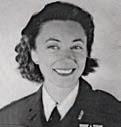

As a local who grew up just up the road from Sweetwater, in Haskell, Moore used dead reckoning—a navigational method of estimating a plane’s current position based on a previously known location, course, speed and time traveled—to ferry planes without working instruments.
Watson of San Angelo was one of just 25 women who qualified for a forerunner to the WASP program. She flew every type of plane used by the Army Air Corps
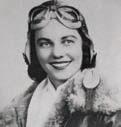

and ferrying aircraft from base to base. The WASPs flew 78 different aircraft, including pursuit planes and bombers, and flight-tested others, flying more than 60 million miles.
Some of the women served as tow pilots, dragging targets 1,000 feet behind their planes so soldiers on the ground could practice firing at them with live ammunition. Others worked as instructors or practiced concealment, learning to lay smoke that would hide personnel on the ground.
Thirty-eight WASPs were killed during their service, including 11 who died in training accidents. The military didn’t pay for their funerals, so fellow WASPs took up collections to send the women’s remains home to family.
About 14,000 people visit the museum in Sweetwater every year, exploring two hangars filled with everything from flight suits to logbooks, part of a tow target, a flight simulator, medals, parachutes and four complete aircraft of the type the women used for training.
Visitors can take a turn at a chin-up bar like one the women used during daily calisthenics or grab a seat in a re-creation of a classroom, where a film leads them through what it was like as an incoming recruit reporting for duty. They can peer into a mock-up of a room in the barracks too.
Mostly, though, visitors can learn who the WASPs were as individuals. “They’ve all got really amazing stories,” Taylor says, sharing a few as she walks through the museum.
When one group of WASPs traveled to California on a mission, they were arrested and briefly jailed for impersonating military pilots, Taylor says. Another WASP made an emergency landing in a farmer’s field, and the family who owned the land fed and housed her for the night. Other stories describe WASPs who had to parachute to safety from their airplanes and WASPs who tested aircraft with engines prone to catching fire.

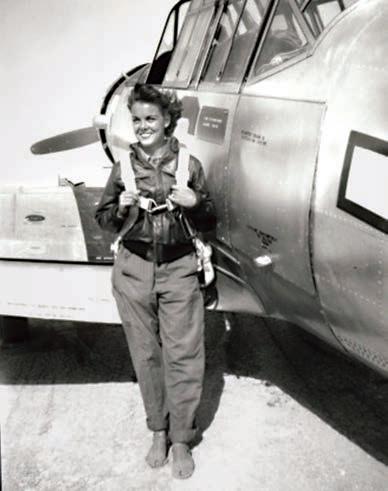
OPPOSITE A graduation ceremony August 7, 1943, at Avenger Field in Sweetwater.
ABOVE AND LEFT Nell “Mickey” Stevenson Bright, 103, knew she wanted to learn to fly when she was 8. She ended up being one of only 20 women chosen to train on B-25 bombers.
WASPs are now gone, their families, as well as members of the public, still attend.
The names of all the WASPs, including those who didn’t complete training, are listed on one wall of the museum, and visitors can access a database that includes information about each one. There are photos and handprints of many of the women.
Each April, the museum hosts a Homecoming Celebration & Fly-In, set for April 25–26 this year. While most of the
The National WASP World War II Museum will celebrate its 20th anniversary at this year’s WASP Homecoming Celebration & Fly-In, Friday–Saturday, April 25–26. There will be museum tours, guest speakers, live reenactors, aviation games and a display of aircraft. For more information, go to waspmuseum.org/ homecoming
At the 2012 homecoming, WASP Nell “Mickey” Stevenson Bright, who is now 103 years old, explained that she skipped meals as a teenager to pay for flying lessons. After becoming a WASP, she remembers standing in a shower wearing her flight suit to clean it.
“The thrill of flying those wonderful airplanes and getting paid for it—that was worth it,” Bright, who is from Canyon, said at the time.
The WASPs were deactivated in December 1944, but it took more than 30 years before President Jimmy Carter signed a bill recognizing them as military veterans. In 2010, President Barack Obama awarded the WASPs Congressional Gold Medals, the oldest and most prestigious civilian award in the U.S. Today, museum officials hope the institution can inspire the next generation.
“These women went to a lot of time and trouble to learn how to fly in a world that wasn’t going to let them in,” Taylor says. “So, what is it that you want to do and try, and what barriers will you need to overcome to leave a good legacy for yourself?” D
Tour Hangar 2 at the National WASP WWII Museum with Lisa Taylor, the museum’s director.

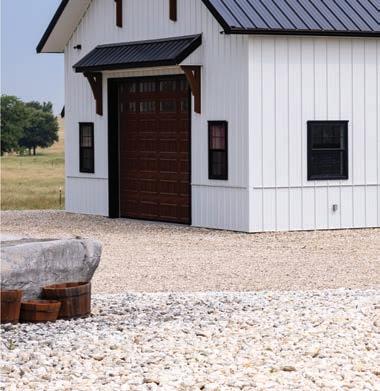








POWERING A HOME using the sun’s energy is not a new concept by any means. With recent technological advances and lower costs, solar power has become an attractive option.
But how do solar panels actually generate electricity? Let’s break down this seemingly abstract concept and take a closer look at the conversion of sunlight to usable electricity.
The solar panels you see on street signs or rooftops consist of smaller, connected photovoltaic cells; “photo” meaning light and “voltaic” meaning the production of electricity. These cells consist of two layers of a semiconducting material, typically silicon, which are the meat of the solar panels.
The cells are infused with additional elements that give the top layer a negative charge and the bottom layer a positive charge. These two silicon layers are also sandwiched between several other coatings, including a glass casing, to optimize the PV cell’s energy production and provide protection from outside debris.
The sun emits massive amounts of solar energy each day in the form of photons, which are small particles of light. When these photons collide hard enough with PV cells, electrons are knocked loose from atoms in the top silicon layer of the cells, leaving gaps to be filled by electrons from the bottom layer. Because of the electric field created by the two silicon layers, the loose electrons will circulate through the cells in a single direction, out toward the metal sides of the solar panel, creating electricity with a direct current.
This is where the power inverter comes in. The newly generated electricity flows out of the panels, through conductive wire and into the inverter system. This system is necessary because
the majority of our home appliances and electronics operate on an alternating current, or AC power.
The inverter converts the power from DC to AC, allowing us to charge our phones and watch TV using electricity generated by solar panels.
Once the electricity is in an alternating current, it flows from the inverter to our breaker box and into our homes as needed. Any solar energy that goes unused will flow through your electrical meter and onto the electric grid.
If the costs make sense and you have a roof suitable for solar, a rooftop solar array may be a good way to reduce your monthly energy bill and help the environment, but please be aware of the costs and responsibilities, including maintenance, any lease or loan fees, and roof work that might be needed.
Be sure to do thorough independent research and not rely solely on information from a solar salesperson.
The cost of solar installation and maintenance can often eliminate any savings in electricity costs. One thing to keep in mind is that much of the energy produced by the solar panels will be consumed within the home to power appliances, lighting and other everyday essentials. Only the unused portion of the solar generation is seen and recorded by the cooperative meter. The amount of energy produced will never equal the amount of energy recorded by the meter.
Call and talk with one of our friendly member service representatives at Grayson-Collin Electric Cooperative before installing a solar array at your home to find out what the policies regarding member-owned generation are and for advice on installing and maintaining the system. D
BACK TO GRID
Any unused electricity travels through your electric meter and back to the electric grid.
An electric field is created when sunlight hits the solar panels.
SUNLIGHT
Electricity is generated and flows into a conductive wire.
The conductive wire carries the DC (direct current) electricity to the inverter, where it is converted to AC (alternating current) electricity, which is used in homes and businesses.
The AC electricity travels from the inverter to the electric panel (or breaker box), which delivers electricity throughout the home.
Written or printed notice stating the place, day, and hour of the meeting and, in case of a special meeting, the purpose or purposes for which the meeting is called, shall be delivered not less than ten (10) days nor more than thirty (30) days before the date of the meeting, either personally or by mail, by or at the direction of the Secretary, or by the persons calling the meeting, to each member. If mailed, such notice shall be deemed to be delivered when deposited in the United States mail, addressed to the member at his address as it appears on the records of the Cooperative, with postage thereon prepaid. The failure of any member to receive notice of an annual or special meeting of the members shall not invalidate any action which may be taken by the members at any such meeting.
Notice of members’ meetings shall include a brief notice of any member resolution. To be valid, a member resolution must be signed by at least 15 members and presented to the Secretary of the Cooperative not less than 60 days in advance of the member meeting at which its consideration is requested. Member resolutions may not infringe upon the power of the board of directors to manage the business and affairs of the Cooperative as provided in the Electric Cooperative Corporation Act, Section 161.071. Accordingly, in order to be valid, a member resolution should resolve that the board of directors consider or consider and favorably or unfavorably act on a particular proposition. Member resolutions that are not timely submitted shall not be included in the notice of the meeting and shall not be considered at the meeting of members.
Section
The territory served by the Cooperative shall be divided into five (5) director districts. The districts and the numbers of directors who shall represent each district are described as follows:
District 1: One Director
Northeastern portion of Grayson County, including Dennison, Bells and Whitewright.
District 2: One Director
Western portion of Grayson County, including Whitesboro, Gordonville, Howe and the Big Arm of Lake Texoma.
District 3: One Director
Central and southwestern portion of Grayson County, including Sherman, Tioga and Van Alstyne.
District 4: One Director
Northwestern portion of Collin County including Celina, Weston, Anna and Blue Ridge.
District 5: One Director
Central and southern portions of Collin County, including McKinney, Allen, Lucas and Parker.
The board of directors may alter the boundaries of director districts from time to time. The Cooperative shall maintain and make available to members for their inspection a map more particularly describing the director districts.
To become or remain a director, a person must meet the following qualifications:
1. Be an individual member of the cooperative for at least 12 months, maintaining a primary residence in the district the director represents, and purchasing electric energy from the cooperative at that residence;
2. Not be employed by or have a material financial interest in a competing enterprise or business that sells electric energy or a supplier, contractor, consultant or any other entity with which the cooperative does a substantial amount of business;
3. Not be employed by the cooperative and not have been employed by the cooperative for a period of two years before becoming a director;
4. Not have been convicted of any criminal offense involving dishonesty or breach of trust;
5. Not have a final judgment entered against the director in a civil action on the grounds of fraud, deceit or misrepresentation;
6. Not have a payment due the cooperative that is more than 90 days delinquent;
7. Not be the incumbent of or candidate for an elective public office in connection with which a salary is paid, other than members of the School Board or County Commissioner’s Court; and
8. When membership is held jointly by the husband and wife, either one, but not both, may be elected a director; provided, however, that neither one shall be eligible to become or remain a director or hold a position in the cooperative unless both shall meet the qualifications hereinbefore set forth.
9. Any person who serves as a director on or after March 1, 2012, other than a director whose service as director commenced prior to that date, shall complete a course of study and submit to the Cooperative a Credentialed Cooperative Director Certificate from the National Rural Electric Cooperative Association (“NRECA”) within 33 months of the date he or she commenced to serve as a director.
Nothing in this Section shall, or shall be construed to, affect the validity of any action taken at any meeting of the Board of Directors.
Section 3.5 Nominations.
It shall be the duty of the Board of Directors to appoint, not less than thirty (30) days nor more than ninety (90) days before the date of a meeting of the members at which directors are to be elected, a nominating committee consisting of not less than five (5) nor more than eleven (11) members who shall be so elected so as to give equitable representation on the committee to the geographical areas served or to be served by the Cooperative. No officer or member of the Board of Directors shall be appointed a member of such committee.
The committee shall nominate one or more (as the judgment of the committee may direct) members as nominees for directors for each director to be elected at the annual meeting, and after such selection or nomination, shall post a list of said nominees
in the principal office of the Cooperative at least thirty (30) days before the meeting of members at which directors are to be elected.
Any fifteen (15) or more members may nominate a qualified person to serve as director by written petition bearing their signatures delivered to the secretary not less than twenty-five (25) days prior to the meeting of members at which directors are to be elected. The secretary shall post a copy of the petition at the same place where the committee nominations are posted, not less than twenty (20) days prior to said meeting. The Secretary shall mail with the notice of the meeting, or separately, but at least ten (10) days prior to the meeting, a statement of the number of directors to be elected and showing all nominations made.
The members may, at any meeting of members at which a director or directors shall be removed, may also nominate a successor or successors from the floor of the meeting.
Notwithstanding anything in this section, failure to comply with any of the provisions of this section shall not affect the validity of any election of directors. D


We love our trees, but when branches are too close to power lines, they can cause power outages, fire hazards and other safety concerns. Here are some rules to follow:
If a tree or a large branch is touching—or falls on—an electric line, call your electric cooperative immediately.
Never trim trees that grow close to power lines; that’s a job for professionals. Call your electric cooperative for assistance and guidance.
Use extreme caution when doing any overhead trimming. Branches often fall in unexpected places.
Don’t allow children to climb trees or build tree houses close to power lines.
Herbert Hoover was the first president to have air conditioning, spending $30,000 to have it installed in the West Wing of the
Plant appropriate distances from all power lines.
When planting a tree, consider how tall the tree will grow. At maturity, trees should be at least 10 feet away from power lines.
Grayson-Collin EC encourages you to always practice safety.

NOTHING SPOILS A FUN DAY of Easter egg hunting like an accident. Stay safe with these tips.
e If you’re using real eggs, buy them no more than a few days before Easter.
e Keep eggs refrigerated until you’re ready to boil them, and cool cooked eggs in the fridge before dyeing.
e Don’t dye cracked eggs. Discard them.
e Hide eggs no more than an hour before the hunt begins. Eggs should not go unrefrigerated for more than two hours. Longer could invite bacteria and food poisoning.
e If you’re hiding some of the eggs indoors, keep them away from electrical outlets, plugs, light sockets and extension cords. Choose hiding places at table height or lower to discourage climbing.
e Outdoors, avoid placing eggs near air conditioning units, low-hanging overhead wires or in trees near power lines.
e Fill in holes and uneven patches of ground in your yard, and pick up anything on the ground that children could trip on. They’ll be focusing on finding eggs, not their footing.
e Place eggs well within the boundaries of your lawn. Don’t put them close to the street or driveways.
e Bushes are great hiding places for eggs—and also for bees, snakes and other critters you won’t want your children near.
e Avoid bushes that are thorny or have recently been sprayed with pesticides.
e To avoid dealing with rotten-egg smell the next day, make a list of where eggs are hidden so you won’t forget to retrieve the ones your little ones can’t find. D
2 cans whole green chiles (10 ounces each), drained
8 ounces grated sharp cheddar cheese
6 slices thick-cut bacon, cooked and cut into bite-size pieces
6 eggs
Dash of hot sauce
Salt, to taste
Ground black pepper, to taste
1. Preheat oven to 350 degrees. Coat an 8-by-8-inch baking dish with cooking spray. Arrange chiles evenly in the dish, then sprinkle on cheese and bacon.
2. In a bowl, beat together eggs, hot sauce, salt and pepper, then pour evenly into the dish. Bake until eggs are firm and cheese has melted, 25–30 minutes. Cool 5 minutes, then cut into squares to serve.
SERVES 9
Find this and more delicious recipes online at TexasCoopPower.com.

Times and terrain may change, but the call to serve our members never does.
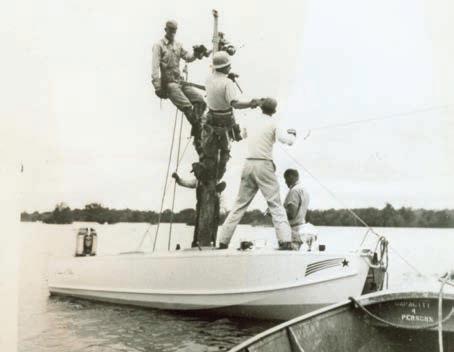

CONTACT US
14568 FM 121, Van Alstyne, TX 75495
P.O. Box 548, Van Alstyne, TX 75495
Office Hours Monday–Friday, 8 a.m.–5 p.m. Local (903) 482-7100 Toll-Free 1-800-967-5235
Web gcec.net
Directors
Steve Robinson, President, Celina
Paul Kirkland, Vice President, Lucas
Jim Copeland, Secretary-Treasurer, Pottsboro
David Ellis, Tom Bean
Dennis Ferguson, Van Alstyne
and to
please
ABOUT GRAYSON-COLLIN EC
GCEC owns and maintains more than 5,300 miles of line to provide electric service to approximately 72,300 members in Collin and Grayson counties.
PAYMENT LOCATIONS
GCEC Office
14568 FM 121, Van Alstyne Night deposit available
Independent Bank—Anna Highway 5, Anna
Cendera Bank Highway 82 East, Bells
Independent Bank—Celina 290 Preston Road, Celina
Independent Bank—Howe 100 S. Denny St., Howe
First National Bank 109 S. Britton St., Tom Bean
VISIT US ONLINE gcec.net Check us out at TexasCoopPower.com/gcec
Grayson-Collin Electric Cooperative does not endorse these individuals or services. Member Market ads are a form of member service.
Building materials—Large barn full of building materials of all types, new. Also cedar fencing 8 ft. x 4 in., new. Call (972) 369-2068.
Furniture—Jenny Lynn baby bed with mattress, $60; traditional baby bed with mattress, $75; 2 infant swings, $25 each; full-size antique brass bed, $125. Call (972) 837-2243.
Antique rifles—Winchester 1886 octagon barrel, caliber .40–82, very good bore and action, very good wood, 100% original, $2,650. Also 1886 .33 WCF, $1,850, full magazine. Call (214) 533-1415.
Golf carts—2018–20 electric and gas Yamaha and Club Car Tempos. Can be refurbished and personalized to your needs or wants with accessories. Call or text TGCG at (469) 424-4042.
Various—Tiger Club equipment, lawn mowers, Cub Cadet, Toro, in Whitesboro. Free crate wood. Call (903) 564-7901.
Various—Hoverboard for sale, in very good shape and has new batteries, $550. Left and right taillights that fit on a 2019 Dodge Ram truck, in very good shape, $50. Call (903) 487-9784 or (903) 337-8250.
Motor home—2020 Coachmen Galleria 24A, 24,300 miles, Mercedes diesel, class B. Great for long or short trips. Call or text (214) 600-0741.
Bee hives Custom layers, easy to inspect, less invasive and minimal lifting and bending. 2x construction, gable roof. 24 frame hive starting at $500. Call (903) 819-8715.
Electric wheelchair—Hoveround XL. Call (979) 285-8370 after 5 p.m. to discuss price.
Riding lawn mower—Husqvarna, 20 hp, 48” mower with 172 hours. Call or text Jerry at (903) 918-3515.
Boat—18 foot, lake ready, completely rebuilt with more than $5,000 spent on the rebuild. Call (972) 369-2068 with offers.
Lodge—5,000-sq.-ft. facility. Available for family reunions, retreats, weddings, etc. Overlooks private lake. RV spots available. Sleeps 24. Full kitchen. Email innkeeper@crescent moon-lodge.com or call (214) 538-0513.
Executive RV storage—In Celina, full service. Fully enclosed, 50-amp series, heated, gated and 24-hour access as well as a water
and dump station. Call (972) 382-3936. Hall—2,000-sq.-ft. facility available for reunions, weddings, receptions, luncheons, meetings, etc. Available every day of the week except Fridays. Also RV spots for lease by day or week. Inquire by phone at (903) 482-9360 or come by American Legion Post 376 at 293 Jay Road in Van Alstyne.
Weston Community Center—Full-day rental. $150 for Weston taxpayers, $250 for all others, with an additional $80 refundable deposit. Rental fee includes tables and chairs for 85 with a full kitchen. Contact City Hall at (972) 382-1001 or visit westontexas.com.
Chapel—Getting married or renewing vows? Historic chapel, beautifully restored, over-looks private lake, seats 100-plus. For an appointment, call (214) 521-2937 and leave message or (214) 522-8000.
Sadler Community Center—Five-hour rental, fee includes space for up to 100 people with tables, chairs and full kitchen. Call or text (903) 819-7918.
Trailers—Enclosed cargo/car hauler, utility/dump, open car haulers, horse trailers. Winches & hitches offered for no additional cost. Visit towrar.com, call (877) 701-1477 or email rightawayrentalsllc@gmail.com.
Trailers—Enclosed cargo (CellTech), utility and car hauler trailers (TopHat). Financing and rent-to-own available. Call Open Road Trailers at (972) 565-1972.
Storage units and parking spaces—UHaul rentals are available too. In Westminister. Call or text (214) 433-3999 or visit allyourstorage.com.
Knives and watches—Old pocketknives and pocket watches. Call (972) 658-6082. Gas pumps—From 1920s–50s. I also sell them restored. Call (214) 808-4621.
Farmers Insurance—Auto, home, life, umbrella, recreational vehicles, commercial. For a policy review or no-obligation quote, call Cindy at (469) 625-1239 or email Janice at jcross-white@farmersagent.com.
Weston Land Co.—If you are looking to buy or sell real estate in the Grayson or Collin counties areas, give us a call at (972) 3828980 or (903) 482-4026.
LaFollett Tree Service—Trees trimmed and removed in the Van Alstyne area. Also British
white cattle available. Call (214) 733-1055. Retired cabinetmaker—45 years’ experience designing and building kitchens, baths, offices, barn doors, entertainment centers. No job too small or too big. Call Tim at (619) 944-2873.
Auctioneer—Jason Orndorff for hire. Benefits, relief calling, any and all types of auctions. Texas License No. 16187. Call (903) 271-5286.
Barnz Custom Designs—Custom hats, awards, signs, laser work and leather stitching. Visit barnzcharmzdesigns.com.
Striper fishing guide—Have been a professional fishing guide since 1979 and furnish everything. Call Ed Fowler at (903) 267-2311.
Eva’s All-Seasons Glass—Serving Grayson and Collin counties. Owner/operator with over 30 years of experience in the glass industry. Residential and commercial services. Visit evasallseasonsglass.com or call (214) 223-9691.
Guitar amplifiers repaired—Vacuum tube and solid-state amplifiers, musical instrument amplifiers repaired and restored. All makes and models. I specialize in vintage amplifiers. Visit crossfireelectronics.com or call (903) 436-1683.
Patterson Real Estate—If you’re looking to buy or sell property in the Grayson and Cooke counties area, please give me a call at (903) 814-3439.
Tractor work—Small to large acreages. Mowing, post holes, bucket work, rolled hay moving, level driveways, fence repair, tree removal, fence row clearing and trash removal, fertilizing and seeding. Call (972) 832-0120.
Catering—For intimate settings, special occasions and corporate events, Expose Your Palate caters to you! Ask about our new drop-off catering service. Visit exposeyourpalate.com, follow us on Instagram @exposurepalatellc or call (469) 2968946. Reserve your experience today! Need to sell real estate? Don’t guess at the price; work with a local pricing strategy adviser. Call Rebecca Yavner, realtor with eXp Realty, at (214) 785-8188.
Garage door and opener services—Residential or commercial, since 1982. Having door problems? Call Glenn at (903) 819-6064. Chimney and fireplace services—Hale’s Chimney Cleaning and Repair. Chimney and fireplace services for all of North Texas since 1993. Repairs, inspections, cleaning and chimney caps. Dryer vent cleaning also. Call (972) 562-6851 or visit haleschimney.com.
Circle N Dumpster Rentals and Junk Removal—Helping you clean up your spaces and places. For all your junk removal
and dumpster rentals, call Frank at (214) 726-2928 or visit circlenjunk.com.
Décor hanging—Former museum couple will hang your pictures, plaques, mirrors, etc. Great references. Call Connie at (214) 735-6187.
Howe Metal Works—Custom CNC and welding. Fences, gates, awnings, etc. Call Zach at (903) 815-3353.
Insurance agent—Medicare plans, final expenses insurance and more. Call your hometown agent for expert, no-cost help. Resident of Grayson County for 16 years. Call Chuck at (972) 979-9221.
Scott’s CNC & Laser—We do custom wood signs, engraving and plastic 3D printing. Call (903) 741-8320.
Handyman—Scott’s Home Remodeling and Handyman. Bathroom remodel, deck, painting, flooring, cabinet maker. Small or big. Contact Scott Randolph at (903) 7057009 or scottshomeremodeling.com.
Trailer rentals and sales—Enclosed cargo/ carhauler, utility/dump, open car-haulers, horse trailers. Winches, hitches, straps included in rental rates. Call to rent/buy a trailer today! Call 1-877-701-1477 or visit towrar.com.
Drone services—High-resolution aerial images and videography. Inspection, find and count animals, map land, construction progress. FAA-licensed remote pilot. Call (469) 905-1936 or visit merlindrone.com.
Local mortgage loan officer—Here to help you purchase your first home or your investment properties. Contact Donnie Roberts with Velocio Mortgage at loanswithdonnie.com

Plant leafy trees to the south of your home to block sunlight in the summer and reduce the need for air conditioning.
Category (check one): ○ For Sale
Free
Wanted
For Rent or Lease
Services
Type or print your ad below and mail to:
Savanna Chandler, Grayson-Collin EC, P.O. Box 548, Van Alstyne, TX 75495
NAME
PHONE ( ) AD
Advertising in GCEC’s Member Market is a free service offered to our co-op members. As we have more than 40,000 members, we often have more ads submitted than we have space to print. Please limit ads to 25 words or fewer and submit only one ad per month. Ads will be placed on a first-come, first-served basis. Ads must be submitted before the 28th of each month to run in the next possible Texas Co-op Power (i.e., April 28 for the June issue). We reserve the right to refuse any ads. Ads must be resubmitted each month to run more than one month. Do not submit ads on the back of your payment stub. These stubs are processed automatically because we receive hundreds of payments daily. Ads for commercial businesses will be printed only if space allows after all other ads are placed.
































BY KEVIN ROBBINS • ILLUSTRATION BY ERIC KITTELBERGER
LEE ELDER WAS 40 when he played in his first Masters Tournament, the spring golf ritual in Augusta, Georgia, that represents the first of the four major championships each season. But his rather advanced age wasn’t the story at all 50 years ago this month—in April 1975. Nor were the death threats.
The Dallas native had become the first African American to compete in the Masters. Augusta National Golf Club, which organizes and hosts the tournament, had finally responded to the civil rights movement of the 1960s. While the club had no formal policy banning Black players, it nonetheless had never extended an invitation to one.
That changed in 1971.
That year, the Masters announced that
any player who had won the previous season on the PGA Tour would automatically qualify—a policy that exists to this day.
Elder won the 1974 Monsanto Open in Pensacola, Florida. It was two weeks after Hank Aaron broke the Major League Baseball home run record set by Babe Ruth.
Elder’s acceptance to play in the Masters generated massive publicity. It felt like a watershed moment in American sports.
“Move over, Hank Aaron,” wrote The Chicago Defender, a Black newspaper. “There’s enough room in the spotlight for at least two people.” The threats soon followed.
In April, as the Masters neared, Elder rented two houses near the course for himself and his wife. He wanted no one
else to know where he would be while competing.
It was all so new and unnerving to the U.S. Army veteran who, along with his nine siblings, had lost his parents when he was young. Born in 1934, Elder caddied with his brother Raymond at Tenison Park Golf Course in Dallas, miles from the nearest course that allowed Black players. He moved to California in the 1940s to live with an aunt.
There he caddied, toiled in bag rooms, did odd jobs in pro shops and gradually learned to hit a golf ball straight and far.
Elder joined the United Golfers Association, a tour for Black players, who were, at the time, excluded by fiat from the PGA Tour.
Elder thrived on the UGA. He won 18 of 22 tournaments in one remarkable stretch. But that wasn’t where the money and prestige were; UGA purses were a pittance. Elder joined the PGA Tour in 1968, seven years after it lifted its Caucasian-only policy.
That August, he took the mighty Jack Nicklaus to a playoff in Akron, Ohio. Elder had arrived. People knew his name.
He eventually won four tournaments in 448 starts on the PGA Tour, including once in Texas, at the 1976 Houston Open. He proved, with Charlie Sifford and Calvin Peete, that Black players belonged in professional golf.
Elder missed the 36-hole cut at that Masters (a tournament he would play five more times) in his 1975 debut. He later said he felt seen in a way he never had.
“The display from the employees at Augusta National was especially moving,” Elder, who died in 2021, told Golf Digest in 2019. “Most of the staff was Black, and on Friday, they left their duties to line the 18th fairway as I walked toward the green.
“I couldn’t hold back the tears. Of all the acknowledgments of what I had accomplished by getting there, this one meant the most.” D
Hearty meals that just might be too good to limit to breakfast
BY VIANNEY RODRIGUEZ, FOOD EDITOR
Team salsa verde! I unapologetically drench salsa verde over all my dishes, but over eggs in a well of hash browns topped with bacon? This is what breakfast dreams are made of. Take this directly from the stovetop to the table and serve it family style.

Salsa Verde, Hash Brown & Bacon Breakfast Skillet
6 strips bacon, diced
6 cups frozen diced hash browns
¾ cup chopped red bell pepper
¾ cup chopped green bell pepper
½ cup chopped onion
1 teaspoon salt
¼ teaspoon ground black pepper
4 eggs
1 cup salsa verde ¼ cup chopped cilantro (optional)
1. In a large skillet over medium heat, cook bacon until crisp. Remove bacon and set aside. Drain, reserving 2 tablespoons of drippings in skillet.
2. Add hash browns, peppers, onion, salt and pepper to drippings. Cook 2 minutes while stirring.
3. Cover and cook about 15 minutes more or until potatoes are browned and tender, stirring occasionally.
4. Reduce heat to low. Make 4 wells in potato mixture. Break 1 egg into each well. Top each egg with ¼ cup salsa verde.
5. Sprinkle bacon over the top, cover, and cook until eggs are completely set, about 8–10 minutes.
6. Serve warm, garnished with cilantro if desired.
SE RVES 4
Follow Vianney Rodriguez as she cooks in Cocina Gris at sweetlifebake.com, where she features a recipe for Honey Flan.

MICHELE BRADLEY
GRAYSON-COLLIN EC
If you crave an easy, sticks-to-your-bones breakfast, this one has it all—veggies, sausage, eggs, cheese and a hint of spice. Served warm with a few slices of creamy avocado, this dish will keep you going all morning.
4 tablespoons extra-virgin olive oil, plus more as needed
1 small potato, diced
½ cup ground pork or turkey breakfast sausage
½ cup diced green bell pepper
½ cup diced red bell pepper
½ cup diced yellow bell pepper
¼ cup thinly sliced portabello mushrooms
2 tablespoons minced garlic
8 eggs
2 tablespoons cottage cheese
1 tablespoon Cajun seasoning
½ teaspoon crushed red pepper flakes
Sliced avocado
1. Heat oil in a large skillet over mediumhigh heat. Add diced potato and sausage. Cook, stirring occasionally, until sausage is cooked through and potato is fork-tender.
2. Stir in peppers, mushrooms and garlic, and cook until vegetables are slightly tender, adding additional oil if needed. Remove from skillet and set aside.
3. In a bowl, beat eggs lightly. Add cottage cheese, Cajun seasoning and crushed red pepper flakes.
4. Pour egg mixture into skillet over mediumhigh heat. Run spoon across bottom of skillet to begin lightly scrambling eggs.
CONTINUED ON PAGE 28 >


Stuffing in a breakfast casserole? This recipe piqued my interest from the start, and boy was I happy I gave it a try. The stuffing addition gives this eggy dish a mouthful of flavor and bite. This casserole will feed a crowd, but you could also keep it for yourself and enjoy it for lunch all week.
9 eggs
3 cups milk
1 box stuffing mix (6 ounces), any flavor
1 pound ground breakfast sausage, cooked and crumbled
3 cups grated cheddar cheese, divided use
1. Coat a 9-by-13-inch baking dish with cooking spray.
2. In a large bowl, lightly beat eggs. Add milk, stuffing, sausage and 2 cups cheese. Stir to combine.
3. Spoon into prepared dish and top with remaining 1 cup cheese.
4. Cover with plastic wrap or aluminum foil and refrigerate overnight.
5. In the morning, allow casserole to sit at room temperature 30 minutes while the oven preheats to 350 degrees.
6. Bake uncovered 40–45 minutes or until lightly browned on top and toothpick inserted comes out clean.
SERVES 12–16
ONE-SKILLET DINNERS DUE APRIL 10
It’s a busy weeknight, and you need an easy one-dish dinner to fill up the family. What’s your go-to? Send us your best skillet stunner, and you could win $500. Enter by April 10.
UPCOMING: CANDIES AND FUDGE DUE MAY 10
RECIPES CONTINUED
5. Stir in cooked potato, sausage and vegetables to evenly coat with egg. Continue to cook until eggs are fully cooked.
6. Serve warm, topped with avocado.
SERVES 3–4
AMY STREET
MIDSOUTH EC
This egg bake packs all the flavors of a breakfast sandwich into a casserole. I love finding great recipes to have on hand for a lazy Sunday morning brunch with ingredients I have readily available in my kitchen. Fresh from the oven, I topped my slice with plenty of hot sauce—delicious!
1 tube crescent rolls (12 ounces)
1 pound pork breakfast sausage

½ cup diced green onion
8 eggs
1 cup milk
1 teaspoon salt
½ teaspoon ground black pepper
1 cup shredded cheddar cheese, divided use
1 cup shredded mozzarella cheese, divided use


1. Preheat oven to 400 degrees. Coat a 9-by-13-inch baking dish with cooking spray. Line crescent rolls along the bottom, pinching seams to seal. Bake 8 minutes, then remove from oven.
2. While crust is baking, cook breakfast sausage in a skillet over medium-high heat, breaking up with a spoon. Add green onion and continue to cook, stirring occasionally, until sausage is fully cooked. Remove from heat.
3. Reduce oven temperature to 350 degrees. Add eggs, milk, salt and pepper to a bowl. Whisk until thoroughly combined.
4. Spread sausage mixture over cooked crescent crust. Sprinkle half the cheddar and mozzarella over sausage. Pour egg mixture evenly over cheese and then sprinkle on remaining half of cheeses.
5. Bake 30 minutes or until top is lightly browned and toothpick inserted comes out clean.
SERVES 12




















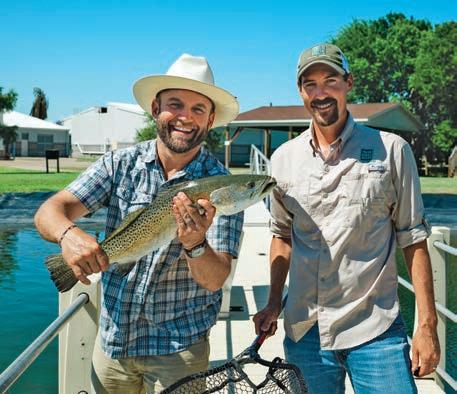
For millions of fish, life starts at Sea Center Texas
BY CHET GARNER
MANY TEXANS WILL spend their entire lives chasing the big one on the Gulf Coast. They’ll traverse marshes and bays in search of a bull red or spec worthy of hanging on the wall or, perhaps more importantly, posting on social media.
I’ve spent my share of afternoons casting but have never had half as much luck as I did in 10 minutes fishing the ponds outside Sea Center Texas in Lake Jackson, about an hour south of Houston. That’s because many of the redfish and speckled trout in our state started their lives right here.
Sea Center Texas is an aquarium, science lab and fish nursery. It’s where the Texas Parks and Wildlife Department breeds fish to populate our waters and educates the public on all the amazing creatures of our coast.
What immediately impressed me wasn’t the live fish but the replicas of state-record saltwater fish covering the lobby walls. Let’s just say the great hammerhead specimen still gives me nightmares.
I walked the halls of aquariums, each focusing on a different underwater ecosystem, from coastal marshes to deeper offshore waters. There was even a touch tank where I held a blue crab (pincers removed, thankfully).
I then grabbed a tour of the back-of-house where TPWD biologists raise millions (literally) of reds, trout and flounder. Outside is a wetlands boardwalk and 75 acres of tanks, including some open for public youth fishing. Luckily I had my kids in tow and was able to reel in a speckled trout much bigger than anything I’ve ever caught before. But, hey, I’ll count it.
It’s just one of the many reasons to plan a trip here instead of chasing the big ones all around the coast. D
ABOVE Chet and Paul Cason, director of Sea Center Texas, with a speckled trout.
Watch the video on our website and see all Chet’s Texplorations on The Daytripper on PBS.
Call ahead or check an event’s website for scheduling details, and check our website for many more upcoming events.
11
Carthage [11–12] Piney Woods Quilt Festival, (903) 754-1948, carthagetexas.com
12
19
Aubrey GreenFest on the Greenbelt, greenfestdenton.com
Lake Jackson Kids Reel Big Fish Event, (979) 297-4533, lakejacksontx.gov
McKinney [12–13] Spring Native Plant Sale, (972) 5625566, heardmuseum.org
Fairfield Easter Eggstravaganza, (903) 389-5792, fairfieldtexaschamber.com
23
25
26
Corsicana [23–26] Derrick Days, (903) 654-4850, derrickdays.com
Burnet [25–26] Highland Lakes Quilt Festival, hlqguild@gmail.com, hlqg.org
Burton Cotton Gin Festival, (979) 289-3378, texascottonginmuseum.org
Castroville Alsatian Festival of Texas, castrovilletx.gov
Channing Hogs at the Point, (806) 935-5598, talonpoint.org
Fredericksburg Volunteer Fire Department Fish Fry, (830) 997-7521, fbgtx.org
Huntington Homestead Festival, shophuntingtontx .com






Taylor [2–3] Chisholm Trail Quilt Guild Quilt Show, ctquiltguild.org
El Campo Cinco de Mayo Celebration, (979) 275-1600, eclostlagoon.com
Fairfield Lemonade Day, (903) 389-5792, fairfieldtexaschamber.com
New Ulm Honey Bee Jubilee, (713) 568-5584, newulmtexas.org
San Marcos Heritage Home Tour, (512) 392-4295, heritagesanmarcos.org
Comfort [3–4] Hill Country Two-Step, texasminimilkers .org
















Not only are these hefty bars one full Troy ounce of real, .999 precious silver, they’re also beautiful, featuring the crisp image of a Morgan Silver Dollar struck onto the surface. That collectible image adds interest and makes these Silver Bars even more desirable. Minted in the U.S.A. from shimmering American silver, these one-ounce 99.9% fine silver bars are a great alternative to one-ounce silver coins or rounds. Plus, they offer great savings compared to other bullion options like one-ounce sovereign silver coins. Take advantage of our special offer for new customers only and save $10.00 off our regular prices.
What makes them iconic? The Morgan Silver Dollar is the legendary coin that built the Wild West. It exemplifies the American spirit like few other coins, and was created using silver mined from the famous Comstock Lode in Nevada. In fact, when travelers approached the mountains around the boomtown of Virginia City, Nevada in the 1850s, they were startled to see the hills shining in the sunlight like a mirror. A mirage caused by weary eyes?



No, rather the effect came from tiny flecks of silver glinting in the sun.















While no one can predict the future value of silver in an uncertain economy, many Americans are rushing to get their hands on as much silver as possible, putting it away for themselves and their loved ones. You’ll enjoy owning these Silver Bars. They’re tangible. They feel good when you hold them, You’ll relish the design and thinking about all it represents. These Morgan Design One-Ounce Bars make appreciated gifts for birthdays, anniversaries and graduations, creating a legacy sure to be cherished for a lifetime.
You can save $10.00 off our regular price when you buy now. There is a limit of 25 Bars per customer, which means with this special offer, you can save up to $250.
Call right now to secure your .999 fine silver Morgan Design One-Ounce Silver Bars. You’ll be glad you did.




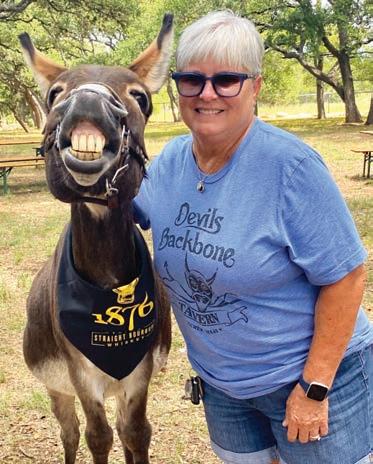
DUE APR 10 College Life
DUE MAY 10 Off-Road Adventures
DUE JUN 10 Heroes
Enter online at TexasCoopPower.com/contests.
See Focus on Texas on our website for many more Characters photos from readers.
Whether your friends be of a feather or the four-legged variety, they bring a unique flavor to life in Texas. As these photos attest, being true to oneself is joyful.
CURATED BY GRACE FULTZ
1 THERESA MCKEE FANNIN EC
“This guy has been iconic over the years. He truly is a Texas character!”
2 PAUL GARCIA MEDINA EC
“It took me forever to get this shot. I had about 10 hummingbirds at my feeder and had an idea about trying to hand-feed them.”
3 MARY CARUTH PEDERNALES EC Cheese! This was taken at Dripping Springs Distilling.
4 AMY SAYLAK BRYAN TEXAS UTILITIES
“A Texas girl with her first cap gun, Sneaky Pete!”
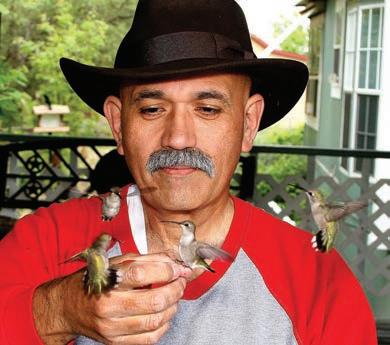

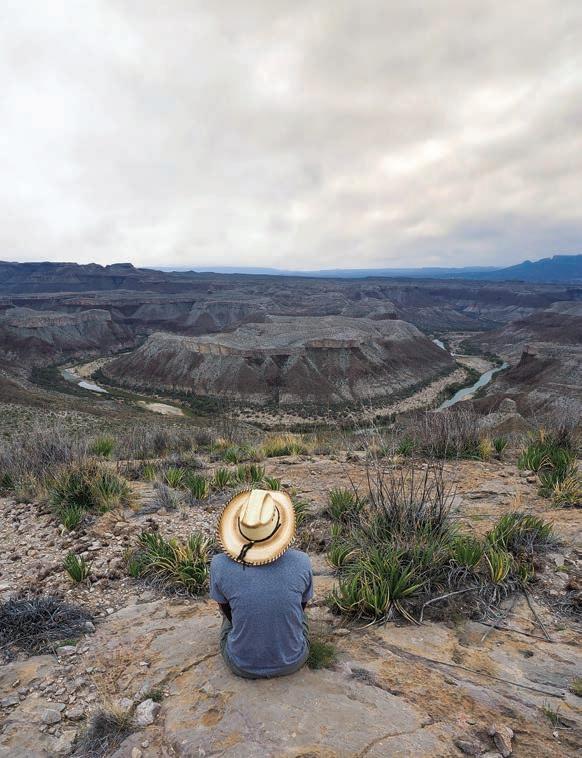
packing trip down the spine of the mesa. Now I make a much easier 2.5-mile jaunt to reach the overlook.
Here, the desert closes in for a prickly hug. With its shattered rocks and cactuses that look like bouquets of steak knives, this remote spot feels like the backdrop of an old Star Trek episode.
You’ve probably seen photographs of Horseshoe Bend at the Glen Canyon National Recreation Area in Arizona, where Instagrammers famously flock to snap photos of themselves high above a U-shaped section of the Colorado River. This, to me, is the Texas equivalent.
To get here from the park’s west entrance, drive 21 miles west along FM 170 to Lajitas. The Mesa de Anguila Trail starts behind the Lajitas Golf Resort, next to a sign that says, “Poisonous snakes and insects may be present.”
The first mile and a half of the trail zigzag through flat desert, dipping into shallow arroyos and winding past scrub. There is no shade; bring plenty of water, even in winter.
After about 30 minutes plodding through the desert, the trail starts to climb up a rocky gully. You’ll get a quadburning workout as you ascend 600 feet over half a mile. You might need to use your hands as you clamber over rocks as big as armchairs and tiptoe through spillways of scree.
BY PAM LEBLANC
BY CHRIS LEBLANC
FROM MY VANTAGE point on the side of a rocky slope high above the Rio Grande, the river looks like a glinting horseshoe far below.
I think it’s the best view in the Big Bend region, and that’s saying a lot. I’ve spent hours gazing down at the rippling desert floor from the South Rim, watching the sun sink behind the Window in the Chisos Basin and peering upriver at Santa Elena Canyon.
But this view, from the western edge of Mesa de Anguila, surpasses all of those, and few hikers make the trip. The mesa, an 11-mile hump of land that juts like a broken pinkie off the western side of Big Bend National Park, is one of the least-visited areas of the park.
I first discovered the overlook six years ago, during a challenging multiday back-
When you reach the saddle at the top, just past the 2-mile point, the main trail continues straight. Instead of following that path, look for a faint trail to your right. Make your way up the hill, then look south, toward Mexico.
Voilà.
Find a good boulder to sit on, and take it in. I could sit for hours, contemplating the way the river embraces the land.
They say horseshoes bring good luck. In this case, I’m sure it does. Anyone who makes it to this spot is lucky to take in such a beautiful view. D





















You may think you know what“priceless” means—usually, it just means “astronomically expensive.” But not at Stauer. Priceless means FREE.
Stauer is smashing luxury norms with our FREE 77-Carat Durango Howlite Necklace. at’s right—zero dollars.* is genuine howlite piece, valued at $299, is yours for FREE—just cover $24.70 for shipping and processing. Plus, we’ll send a $25 Discount Coupon, making shipping Better an Free! No tricks, no obligation—though resisting our luxury deals won’t be easy.


Why give away jewelry? Because once you see Stauer’s rare gemstones and vintage-inspired watches, we know you’ll fall in love. If not, keep your FREE necklace—no hard feelings.
Howlite, discovered in Nova Scotia, has been a gemologist’s secret, often compared to turquoise. Our Durango Collection channels classic Southwest jewelry, featuring blue-green beauty in oxidized silver settings. Get nearly 160 carats for just $79!
is deal won’t last—we only have 2,500 left. Call now to claim your FREE necklace and experience a new kind of priceless luxury!
Jewelry Speci cations:
• Enhanced howlite.
• Oxidized silver finish.





• Necklace: 23" + 2", lobster clasp.
• Earrings: 3" drop, French wire.
• Bracelet: 7", elastic.
Durango Collection— Call In Only
A. Necklace (77 ctw) $299 FREE* + S&P




